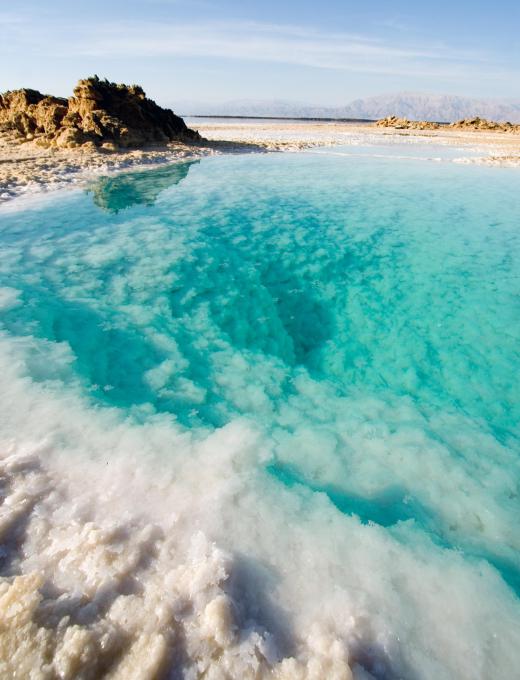What is Bromine?
 Mary McMahon
Mary McMahon
Bromine is a nonmetallic chemical element that bears the distinction of being the only nonmetallic element that is liquid at room temperature. It is highly toxic and extremely reactive, requiring extreme care when it is handled. Bromine is used in an assortment of industrial compounds and cleaners, and it is readily available from a number of sources. People who have a swimming pool or hot tub may already be familiar with with this element in the form of tablets that are used to treat water.
The element is identified by the symbol Br on the periodic table of elements, and it has an atomic number of 35. The name is derived from the Greek bromos, for “stench,” a reference to the characteristic sharp and unpleasant odor of bromine. It is classified among the halogen elements, which share the traits of extreme reactivity and the ability to produce salts when exposed to metals. In addition, all halogen elements are nonmetallic, and they exist in all three states of matter at or near room temperature.

Bromine itself is a heavy reddish brown liquid. It is very corrosive, making handling of it extremely inadvisable without protections, and it is also highly volatile. The vapor has a quite unpleasant smell, which also alerts people to dangerously high concentrations of bromine. Some chemists believe that it is difficult to be seriously injured by bromine because the smell will drive a person out of the room before the element hurts him or her. It is still an excellent idea for people to cover their eyes, nose, and mouth when working with bromine, and gloves should always be worn as well.

The element was discovered in 1826 by Antoine Balard, who was exploring the contents of the water in sea marshes. In addition to discovering and naming bromine, Balard also worked on other elements, such as chlorine. By 1860, the element was being manufactured on a large scale from seawater and deposits of salts. Brine wells continue to be a major source, and the Dead Sea is another abundant source of the useful element.

In addition to being used in water purification, bromine is also used as an antiseptic agent and sanitizer. Photo chemicals also contain it, and it can be found in dyes, fumigants, and anti-knock mixtures for automotives. People may note that many of these compounds are considered toxic, and that their handling directions include protection of the eyes, airway, and skin.
AS FEATURED ON:
AS FEATURED ON:
















Discussion Comments
Articles are circulating on FB that Mt. Dew contains "brominated vegetable oil". Is this an acceptable amount to ingest? Why does the FDA allow it? Is it used in other sodas?
What does bromine smell like? What is the state of matter at room temperature for Bromine? Is it flammable? What does it feel like?
@anon9692: It says it right there in the article... it's named after the latin word "bromos."
How do i get rid of bromine in my body?
why does it say " unbrominated " on the bag of cooking flour?
why is it called bromine? is there like a french word or something behind this scientific element?
Post your comments